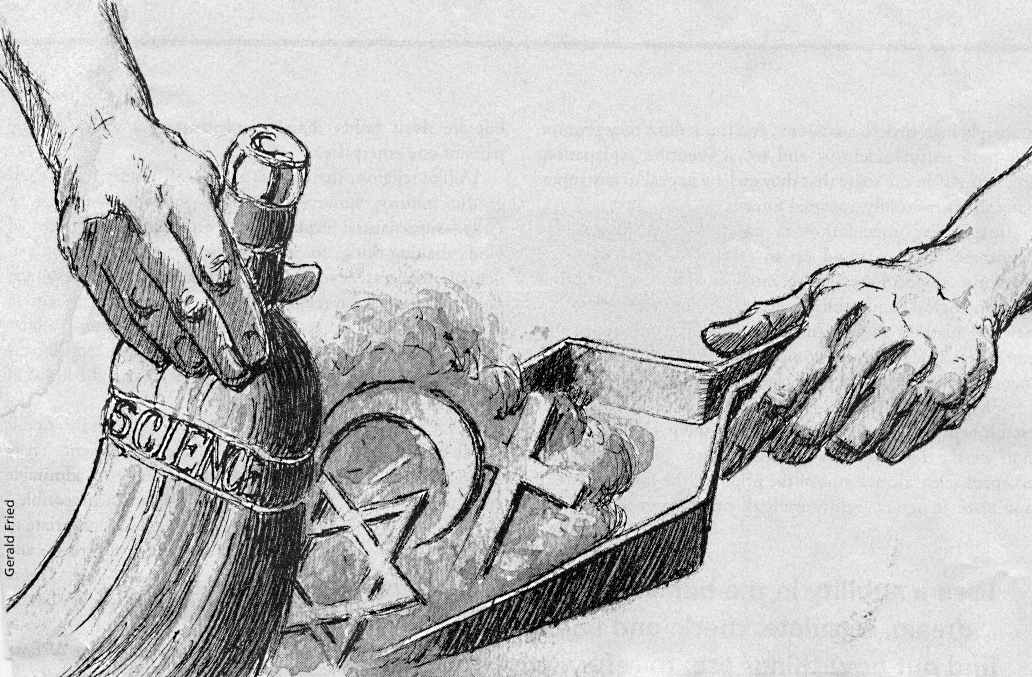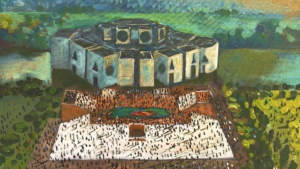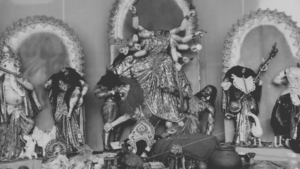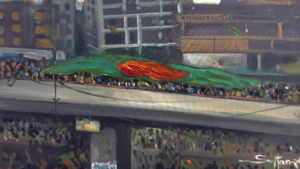
http://goo.gl/rtqEbz
[Following is the text of the lecture titled ‘The Future of Secularism’ delivered at the Independent University Bangladesh on 15 June 2015.]
My heartfelt thanks to the School of Liberal Arts and Social Sciences of the Independent University of Bangladesh, the Mahmuda Khatun Siddiqa, Abdul Ahad and Hamida Khanum Smriti Parishad, and the Bangla Academy for the invitation. I feel honored and humbled to have the opportunity to share my thoughts with you. This occasion places me in the company of eminent scholars whom I admire very much. The invitation to me reflects more on the generosity of the organizers than on my qualifications. I know you expect me to say something useful, something worthy of discussion; of my ability to do so I am doubtful. But I will try my best.
This lecture, and two others which preceded it, are dedicated to Professor Salahuddin Ahmed. Throughout his career Professor Ahmed had written and spoken about secularism, enriched our understanding of the concept, drew our attention to its implications, and worked towards establishing a Bangladesh which would embrace the essence of secularism. As such, no other issue could have been chosen for the memorial lectures named after him. Discussion on secularism is the most moving and befitting tribute to his life and work, and an appropriate step in taking forward his legacy.
As for the timing, it couldn’t have been any better. Over the past decades secularism as a concept and as a phenomenon, as a world view and as a statecraft have been at the center of discussions among social scientists, and policy makers around the globe. Ardent proponents and strident opponents have engaged in battles, literally and metaphorically. Normative and empirical aspects of secularism, its strengths and weaknesses, its past and future are being debated from various perspectives. These debates are influenced, and in some instances shaped, by specific national experiences. Transformations in the global political landscape, significant changes in the body politic in various countries, commencement of democratization processes in various countries, the growing influence of religion in politics and in the public sphere, and changes in the demographic composition of many European countries are some of the factors which have brought the issue to the fore. Also instrumental in its prominence in academic discourse are the emerging perspectives in social sciences, and challenges to the conventional wisdom. Study of religion, its role and secularism have increased manifold. Facile explanations have become a staple of the media, but fortunately, rigorous analyses have also made their mark. In Bangladesh, although the term is a familiar one in our political discourse and appears in the constitution, incisive explorations of the concept in general, particularly in light of the new debates, and its implications for society and politics, have been limited, to say the least.
Discussion of secularism is fraught with problems. Disentangling the topic from passionate, polemical assertions is one issue, another is to reconcile the extant contradictions between two approaches: secularism as a universal ideology with a linear trajectory versus the overwhelming importance of the context or the particularity with little regard to the overarching framework. Neither approach can exclusively address the issue judiciously.
Mindful of these challenges, I have set a limited goal for myself: to offer a critical interrogation of the concept of secularism. My point of departure is that secularism should be viewed as a contested and contestable concept. Specifically, we must acknowledge that ‘secularism is a historically shifting category with a variegated genealogy.’ 1 Perhaps one has to be ready to overcome what Jurgen Habermas has described as ‘narrow secularist consciousness’ 2 to appreciate that the meaning of secularism can be negotiated and renegotiated as much as the institutional arrangements regarding religion and politics can be varied.
What is Secularism and Secularization?
The most common understanding of secularism is that it offers an ideological framework for the relationship between state and religion. Consequently, it entails institutions that will enforce the public settlement and maintain a separation between these two. Within this framework, it is posited that ‘for secular reasons religion should be excluded from political life’, that ‘the state should not act on religious reasons or enforce religious purposes’, and that ‘religiously motivated persons and groups should not participate in political affairs unless they are prepared to set aside their religious convictions and rely on secular considerations.’ 3 One of the earliest definitions of secularism can be derived from George Jacob Holyoake, who is credited with coining the term. In 1851, in his book The Principles of Secularism, Holyoake defined secularism as follows:
Secularism is the study of promoting human welfare by material means; measuring human welfare by the utilitarian rule, and making the service of others a duty of life. Secularism relates to the present existence of man, and to action, the issues of which can be tested by the experience of this life – having for its objects of the development of the physical, moral and intellectual nature of man to the highest perceivable point, as the immediate duty of society; inculcating the practical sufficiency of natural morality apart from Atheism, Theism, or Christianity. 4 The definition has since evolved, but to claim that it is bereft of any ambiguity will be erroneous. Despite the widespread use of the term Charles Taylor concluded that, ‘it is not entirely clear what is meant by secularism.’ 5 As three different disciplines, philosophy, sociology and political science, have addressed the issue of secularism, three different interpretations are commonly attached to the concept. Philosophically, it can be described as rejection of the transcendental and metaphysical in favor of the existential and empirical; sociologically, the term entails the gradual decline of religion’s influence on public life and social institutions; and politically, it is seen as the separation between private and public spheres, represented by the separation of state and religion – these are the dominant explanations of the phenomenon called secularism. 6 These interpretations are not mutually exclusive; instead together they constitute a political doctrine. Like any political doctrine secularism has emerged as a response to a perceived inadequacy or to correct a perceived flaw introduced by an extant idea or system. In this instance, religion is considered to be that inadequacy. It is also worth noting that no political doctrine is free from the power relations in society. The discourse of secularism is shaped by uneven exchanges with various kinds of power – political, intellectual, cultural and moral. The juridico-legal interpretation of secularism provided by the Turkish Constitutional Court exemplifies its expansive nature. In a verdict delivered in January 1998, the Court stated that secularism means separation of ‘social life, education, family, economy, law, manners, dress codes etc. from religion.’ 7 From this point of view, the doctrine is overarching and brings social, political and moral behaviors under its purview. Saba Mahmood, in some ways, provides a similar kind of interpretations when she says, ‘secular liberalism cannot be addressed simply as a doctrine of the state, or as a set of juridical conventions: in its vast implications, it defines, in effect, something like a way of life.’ 8
To some degree, this definition of secularism has blurred the boundary between secularization and secularism. But in most academic discourse, the distinction is made in clear terms. While secularism refers to the doctrine or policy that insists on separation between state and religion, secularization refers to the process which creates a distinction between private and public spheres and relegates religion to the private sphere; and also reflects the gradual decline of religion’s influence in society. Peter Berger defined secularization as the ‘shrinkage in the role of religion, both in social life and individual consciousness.’ 9 Although the secularization thesis became a subject of intensive discussion in the twentieth century, it has a long tradition. Social scientists of the nineteenth century, such as Auguste Comte, Herbert Spencer, Emile Durkheim, Max Weber, Karl Marx, all addressed the issue of the role of the religion from different perspectives, and concluded that over time religion will lose its importance and influence in the society. This argument was based on the understanding that ‘modernization’ will gradually push religion out of public sphere. Jose Casanova argued that secularization means three processes; they are: 1). ‘the decline of religious beliefs and practices in modern societies’; 2) ‘the privatization of religion’; and 3) ‘the differentiation of the secular spheres (state, economy, science).’ 10 Proponents of the secularization theses 11 cited empirical data demonstrating declining attendance in religious institutions primarily in western countries, and acceptance of religion as a private faith by many, as evidence of the validity of the secularization thesis. But by the late-twentieth century, the emergence of religious movements and religio-political forces in various parts of the world brought the first two points into question. Those who proclaimed the death of God revisited their positions. 12 Proponents of the secularization thesis, for example, Peter Berger, expressed a mea culpa. In 1996, he proclaimed, ‘the assumption that we live in a secularized world is false.’ 13 However, we must acknowledge that the third element, the differentiation, has implications beyond the discussion on secularism; because it is the hallmark of the liberal capitalist nation-state as we can easily identify from the dominant idea of making a distinction of “state” from “society,” or the public from the private.
Two questions are pertinent here: How was the concept of secularization made universal? What is the relationship between secularization and secularism? The universalization of secularization thesis is tied to the spread of modernization theory. In the post WWII era, modernization theory insisted that ‘developing’ or ‘non-western’ societies are bound to adopt a linear path of progression, akin to western countries, from traditional societies to ‘modern’ societies, which will bring prosperity and a shift in culture. Economic development will replace traditional values, of which religion is an integral part, and thereby a decline in the influence of parochialism and religion will ensue. Uncritical acceptance of this ideology and model of development promoted the appearance of secularization as a universal idea. The relationship between secularization and secularism is yet to be explored in depth. But based on the available narrative of European history, it is argued that secularism as a state principle emerged after the European Wars of Religion when religion and society progressively accepted the differentiation. As such, secularization of the ‘sacred’, that is Christianity, led to the emergence of secularism as a political ideology.
In non-western societies, the process is distinctly inverted, where we witness secularism as a state principle and a state project is established well before the foundation of secularism is built. General speaking, we can identify four routes to modernity. The first historical route is the Western and Central European route – where modernity was an internal development. The second route is where European settlers arrived: the ‘New Worlds’ of the Americas and Australasia. The settlers constituted the majority and the opposition was marginalized through force. The third route is the ‘colonial zone’ where modernity arrived from the outside. Resistance was suppressed but didn’t disappear. The fourth route was ‘externally induced modernization’ where the ruling elites selectively imported various elements of modernity. Most nonwestern societies were exposed to modernity through the third and fourth routes, making political modernity an implanted idea rather than an internal development. 14 T N Madan argued that, secularism, like modernity, was imposed: ‘models of modernization prescribe the transfer of secularism to non-western societies without regard for the character of their religious traditions or for the gifts these might have to offer.’ 15 As such, secularism as a political doctrine arrived before the process of secularization was even conceived of. The common perception is that the adoption of secularism as statecraft will lead to the process of secularization of society.
On the issue of modernity, I would like to note my reservation on accepting modernity as a meta-narrative, as a single linear tradition. I am of the opinion that the fundamental premise of the modernization thesis that the European project of homogenizing is universal is wrong. I completely agree with Talal Asad when he questions whether modernity means a description or a normative judgement. 16
Transformations of ‘secularism’
The current meaning of secularism has emerged through three distinct transformations. Etymologically, secularism comes from the word saeculum, a unit of time. Romans used it as equivalent to generations as well as the normal life cycle. Gradually it was standardized as a century. The first transformation of the meaning took place with the binary differentiation within Christianity in the thirteenth century. The bifurcation was between ‘eternity’ and ‘temporality’ – ‘priests who withdrew from the world (saeculum) formed the religious clergy, while those who lived in the world formed the secular clergy.’ 17 The former were devoted to purely religious vocations while the latter were engaged in secular vocations. This served as the foundation of Augustine’s distinction between the City of God and the City of Man. The second transformation came in the sixteenth century when the term’s affiliation with Godlessness was discarded; thereafter secularize meant the transfer someone or something from ecclesiastical to civil possession. This meaning gained prominence after a series of wars between the Catholics and Protestants known as the Thirty Years’ War (1618-1648). To a great extent the Peace of Westphalia (1648) institutionalized this meaning of secularism. But there were two elements of these treaties; one that firmly established the principle that issues between states would be resolved without reference to religion; while the other was stipulated within states, cuis regio, eius religio (whose rules, his religion). That means religion was removed from international relations but the idea that states can be founded on the basis of religion was not discarded; in other words, ‘this legitimated confessional states.’ 18 The third transformation took place in the nineteenth century when Holyoake coined the term secularism and afterwards it became identified as a movement to disentangle the relationship between religion and politics. By the following century, secularism is posited as an integral part of progress and development.
The transformation of the meaning of secularism evidently shows that it is not a static concept and that over the past seven centuries it has undergone changes. Therefore, to accept the current usage as the final version of the concept is premature.
It is against this background, in recent decades, that questions have been raised whether ‘secularism as a political doctrine provides a perspective adequate for studying and analyzing the contemporary challenges of religion in politics, law and public life at the macro- and micro-levels, in the public sphere and in everyday practices.’ 19 The contestation and/or challenge to secularism is not only due to religion’s emergence as a formidable political ideology. The failure of the predicted decline of religion in public life or that of privatization of religion in nonwestern societies as well as the reemergence of religion in western societies as a force is one factor encouraging critical assessment. But the call for reassessment is primarily because of the perceived flaw in the ‘conceptual and normative structure of secularism’ itself. Opposition to ‘secularism’, at least the extant dominant version of secularism, is voiced by a wide array of social scientists; they include Partha Chatterjee, Ashis Nandy, T N Madan, Talal Asad, Charles Taylor, William Connolly, John Keane, Craig Calhoun, and Jurgan Habermas , to name a few. While others, such as Rajeev Bhargava and Achin Vanaik, have argued in favor of the conceptual validity of secularism, they too underscored that reformulation of the concept is needed. The intensity of criticism can be understood from Nandy’s unequivocal statement that secularism ‘as a generally shared credo of life is impossible, as a basis of state action is impracticable, and as blueprint for the foreseeable future impotent.’ 20
One of the key elements that bind them together is their critique of reason as the fundamental basis of secularism. Until recently, secularism was praised for its dependence on rationality; it was viewed as the result of the Enlightenment which underscored reason, analysis, and individualism in opposition to traditions and religions. But whether ‘reason’ has been given more than its due eminence has become an issue of debate. Steven Smith, summarized the essential point of this debate in his book, “The Disenchantment of Secular Discourse,” when he argues that there are no secular reasons, at least not reasons of the kind that could justify a decision to take one course of action rather than another. He goes on
. . . the secular vocabulary within which public discourse is constrained today is insufficient to convey our full set of normative convictions and commitments. We manage to debate normative matters anyway — but only by smuggling in notions that are formally inadmissible, and hence that cannot be openly acknowledged or adverted to.
In the context of debate on secularism, Craig Calhoun states,
in arguing against religion a number of advocates for reason fall back on unfortunately simplistic – indeed fundamentalist – accounts of reason. They imagine reason as somehow more complete in itself than it possibly can be. Such accounts are both untenable and an obstacle to greater reconciliation and common understanding among citizens. The argument about reason is overdetermined, however, by the tacit identification of secularism with enlightenment and modernization and religion with mere tradition and backwardness. 21
In similar vein, Gorski et al sharply criticize the secularists for their faith in reason, ‘Perhaps it was the secularists rather than the religionists who were blinded, not by the darkness, but by les Lumières of Enlightenment reason.’ 22
Critics have not only pointed to the conceptual inadequacies of extant secularism, but also advanced remedies for the perceived weaknesses. These include Jose Casanova’s concept of public religions, 23 Alfred Stepan’s ‘twin tolerations,’ 24 Charles Taylor’s ‘radical secularity’ 25 and Rajeev Bhargava’s ‘principled distance’ 26, to name a few. Stepan’s ‘Twin tolerations’ insists on a clear distinction and a mutual respect between political authorities and religious leaders and bodies. ‘When true differentiation is accomplished, the religious sector enjoys freedom of activity and the ability to peacefully influence its members but does not wield direct political power.’ 27 In similar vein, Bhargava’s ‘secularism based on principled distance accepts that religion may not have special public significance antecedently written into and defining the very character of the state or the nation, but it does not follow from this that it has no public significance at all.’ 28 Space and time will not allow me to explain and critique these suggestions in detail, nor do I intend to exhibit preference for one or the other, but simply to underscore that the concept of secularism is being revisited and experiencing a fourth transformation.
Secularism as a Statecraft Principle
Of the two aspects of secularism, statecraft principle is perhaps the most influential aspect as it relates to the daily lives of citizens. What is meant by secularism as statecraft principle, is some principle of separation between religious and political authority, either for the sake of the neutrality of the state vis-à-vis each and all religions, or for the sake of protecting the freedom of conscience of each individual, or for the sake of facilitating the equal access of all citizens, religious as well as nonreligious, to democratic participation. Such a statecraft doctrine neither presupposes nor needs to entail any substantive “theory,” positive or negative, of “religion.” 29
It is generally agreed that, as a statecraft doctrine, two principles are essential: the principle of separation, and that of state regulation. However, at some level these two principles are inseparable. Based on this understanding, since the nineteenth century four models of ‘secular state’ have emerged. They are commonly referred to as the French, British, American and Indian models. Although some scholars have divided these models into two broad strands – assertive secularism and passive secularism 30 – the differences between them require that we maintain this four-fold division for our discussion. The French model’s central premise is that the state protects individuals from religion and by extension publicly controls religion. This model, known as laïcité, banishes religion from the public sphere – both political and social. In short this can be defined as the neutrality of the state towards religious beliefs, and the complete isolation of religious and public spheres. Olivier Roy has argued that laïcité is an ‘exacerbated, politicized, and ideological form of Western secularism’ and that it has both legal and ideological elements. 31 He is correct in saying that ‘it is futile to think of laïcité as a simple relation between state and religion; it sets out the way in which society defines itself politically.’ 32 In the United States, the notion of secularism is codified in the constitution through the First Amendment: “Congress shall make no law respecting an establishment of religion, or prohibiting the free exercise thereof.” This is commonly referred to as the ‘wall of separation’ or ‘separation of church and state.’ This can be viewed as separating church and state to protect each from the other, instead of trying to control religion in the public sphere. Under this interpretation of separation, the society remains highly religious yet the state maintains a distance from religion. The British model is built on a highly secular society whereas the state remains, even if symbolically, connected to religion. The British monarch is the Supreme Governor of the Church of England, and 26 bishops sit in the upper house of government, the House of Lords. But secularization of society, at least in the sense of differentiation, is well entrenched. The Indian model of secularism, sarva dharma sambhav (literally, all religions are true and equal) stresses that ‘all religions are meaningful and that they should have a valid place in the life of nation’. 33 The policy provides guidance to the state but the relationship between state and religion remains fuzzy. This policy renders the issue of secularization of civil society, to borrow Achin Vanaik’s phrase, ‘effectively [a] non-question.’ 34
These models of secular states are not merely reflections of secularism as a worldview, but more importantly are results of historical developments: ‘the emergence of a secular state in Western democracies was more a practical consequence of a specific historical experience than an institutionalization of an abstract secular ideal. It represented the lessons learnt by both church and state from a history of debilitating religious-sectarian strife when such separation was not operative.’ 35 Take for example the French model, the strident version of the secular state emerged because of the strength of the clerics, their roles in revolution and the anticlericalism which permeated society. The hostility of the right-wing Catholic nationalists towards the Republic shaped the Republic’s determined response in the shape of laïcité. ‘This stronger version of secularism was the product of unchurching struggles – struggles against priestly authority – that continued through the nineteenth and into the twentieth century.’ 36 Therefore, secularism as a statecraft, has wide varieties. There is no single model of the secular state.
Secular State under Fire?
One of the recurrent themes of the discussion on secularism is the performance of secular states in nonwestern societies. It is generally observed that that secular state’s performance has implications for the rise of religion as a counter hegemonic ideology and religio-political force posing a challenge to the state. Opponents of secularism (please note, opponents not critics), often insist that the secular state has failed and that the failure is due to its ideological stance.
To assess the connection between the performance of the secular state and challenges to secularism, it is imperative that we recall a few points regarding the state in nonwestern societies. First, historical accounts show, (as I have indicated earlier), that the origins of the state in nonwestern societies are either colonial, or, where they are not (for example, Thailand, China, Russia or Turkey), they are engaged in the conscious attempt to modernize based on a European model. Notwithstanding the fact that these states have their own local peculiarities, ‘they have been “parachuted” by colonial rule and then taken over, lock, stock, and barrel, i.e. in their territorial claims, administration, and legal structures, by “independence movements.”’ 37 The state that is transplanted comes with an ideological baggage, which includes secularism. Second, secular nationalism, particularly in postcolonial societies, ‘derives its legitimacy not from History or the past but from the promise, not from origins but from its desirable effects.’ 38 Thus, it is judged based on its performance in delivering promises. Third, the state in nonwestern, particularly in postcolonial societies, becomes a central institution, often stronger than society. The state is central not only in terms of its economic activity but beyond that to those functions that are essential to the economic process, and as an agency of hegemony/domination. Under these circumstances, the ruling classes, whoever they may be, utilize the agency of hegemony/domination aspect, and through it, a new ideology (or value system), assumed to be superior to all others, is imposed. Often this new ideology is a variant of secular nationalism. Secular nationalism then becomes the legitimizing ideology of the ruling class and an interventionist and predatory state. Secularism, in such situations, is not only sponsored by the state, but also a project of the state.
These three characteristics of the state in nonwestern societies make secularism and state inseparable. Therefore, the performance of the state becomes an important issue. In 1994, Mark Juergensmeyer argued that, “In many parts of the world [the] secular state has not lived up to its own promises of political freedom, economic prosperity, and social justice.” 39 William Miles’s study published in 1996 reaffirmed these findings and added that the ‘religious dimension to group identity and statist politics’ are additional factors. 40 We can say that the lack of performance legitimacy of the ruling elites (that is, the inability of the secular elites to deliver common goods); the brutal authoritarianism that results in an erosion of the civil society and hence leaves the religious centers (e.g., mosque, temple, church) as the only viable public space; uneven economic development including urbanization; rupture in the hegemony of secularist politics; and the politics of expediency of secular parties, are pivotal in the global rise of religio-political forces. 41 The importance of religious centers in the event of the absence of other avenues of political expression needs to be highlighted. These institutions provide a physical and moral space, moral leadership and authority and a logistical basis for mobilization. Importantly, these factors are not mutually exclusive, and their simultaneous occurrence is not necessary.
An authoritarian system of governance has remained the defining feature of many countries in North Africa, West Asia, and South Asia for decades. Countries such as Algeria, Egypt, Iraq, Syria, Sudan as well as Pakistan, Bangladesh, Sri Lanka, Nepal can be cited as examples. Non-realization of the democratic aspirations of the people mark the history of these countries. These failures have delegitimized the states and the ruling elites. As the ruling elites no longer enjoy hegemony over the masses, conflicting tendencies have emerged within these societies. On the one hand, the ruling elites resort to various means to continue their hold over power; while religio-political forces attempt to demonstrate that failure is inherently connected to the secularist liberal ideology. In the absence of a hegemonic ideology, religion becomes a candidate to fill the vacuum. The public discourse is then filled with religious symbols and idioms. This is also true of India, often described as the largest democracy in the world. In India, the Congress lost its appeal to the masses as the Indira Gandhi regime (1971-1977) became more authoritarian and used religion for short-term gains. One can hardly disagree with Varsheny that in the 1980s, the Indian Congress “once a powerful organization associated with founding and building the nation, [became] .. a rusty, clay-footed, colossus.” 42 Additionally, “By the late 1980s, there was an organizational and ideological vacuum in Indian politics. Organizationally, the Congress was listless. Ideologically, it was not obvious what it stood for.” 43 In all these instances, religio-political forces have emerged as key players within mainstream politics.
In the event of the emergence of state-sponsored secularism, ‘sharper disparities between the modernizing-secularizing pretensions of the state and the slower changing realities of civil societies’ become palpable. The state often fails to reduce the overall influence of religion because of the absence of secularization; in fact, religious influence is displaced onto civil society where it remains as a latent force fully capable of resurfacing and entering on to the state domain. 44
By Way of Conclusions
Although I neither want nor can I offer definitive summaries, let alone a conclusion, to the perspectives, discussions and debates I have referred to thus far, let me try to make a few points by way of the conclusion.
First, challenging the extant binary conceptualization – “conservative” religion versus “progressive” secularism – is long overdue. This is necessary because the common understanding of secularism is epistemologically tied to a specific interpretation of a religion, and the narrative equating secularism with modernity, reason, and freedom is questionable. Granted, to many this is a redundant point, because a rich tradition of critiquing secularism from this perspective has already emerged. But considering the state of study of secularism in Bangladesh, it appeared to me that a reminder is badly needed.
Secondly, I have tried to highlight the point that there is no single formulation of secularism. Variations exist – both as an ideology and as a statecraft. Normatively and empirically, secularism has taken different shapes; it is imperative that we are cognizant of this fact. Of course, such variations are products of the specificities of the society and state, but are not the only source of the diversity. To speak of secularism in the singular, implies the claim of universality of an ideology. Therefore, perhaps we should refer to the phenomenon, in plural – secularisms.
Thirdly, future prospects and trajectories of secularisms in South Asia in general and particularly in Bangladesh warrant robust discussion. In this context, I concur with T N Madan, “the transferability of the idea of secularism to the countries in South Asia is beset with many difficulties and should not be taken for granted. Secularism must be put be in its place; which is not a question of rejecting it but of finding the proper means for its expression. In multi-religious societies, such as [in] South Asia, it should be realized that secularism may not be restricted to rationalism, that it is compatible with faith, and that rationalism (as understood in the West) is not a sole motive force of nation state. What the institutional implications of such a position are is an important question and needs to be worked out.” 45
Fourthly. I would also like to add to the preceding statement that the institutional arrangements must be arrived at through a participatory democratic political process that allows vertical and horizontal interactions of the citizens, irrespective of their ideological orientations. My position in this regard is akin to Charles Taylor’s argument that, ‘we think that secularism (or laïcité) has to do with the relations of the state and religion, whereas in fact it has to do with the (correct) response of the democratic state to diversity.’ 46 Therefore, the interactions I am referring to must be based on the fundamental principles of democracy, i.e., tolerance and protection of pluralism and diversity. Democracy guarantees individual rights and liberties for all, regardless of religion, gender, political persuasion, and so on. Digression from these principles to justify secularism does a disservice to the cause.
Fifth, let me reiterate in unequivocal terms, in case my drift is not clear in the arguments I have made throughout the lecture: I am not advocating for an alternative to secularism, but alternative secularisms. I underscored the need to participate in ongoing conversations about the role of religion in politics and public life without an a priori solution in mind and without a specific institutional arrangement as a goal. Instead, since secularism, even when it is spoken of in the singular entails various perspectives and different institutional arrangements, and because it has emerged as a result of different configurations of power relations it is necessary to view it as a dynamic concept.
As I reach the end point of my talk, I would like to finish with a quotation from Vincent Pecora (co-director, with Jonathan Sheehan) of the “After Secularization” project of the Social Science Research Council, which is intended to explore new approaches to the study of religion and modernity; he writes, “it is now impossible to avoid the conclusion that secularism itself is not simply a word that defines a negative condition—the absence of religious belief, whatever that might be taken to mean—but rather a term that occasions almost as much ambiguity and difficulty as “religion.” Whether we consider the work of figures like Ashis Nandy, for whom secularism represents a particular imposition of Western values in non-Western religious communities, or that of Talal Asad, for whom secularism is the agenda of a specific regime of what Michel Foucault called “governmentality,” we no longer have the luxury of seeing the secular in some neutral, non-historical, non-political, and purely rational light.” 47
I hope this will serve as the point of departure for the discussion that will follow these three days of seminar.
Thank you all for joining the conversation.
Thumbnail Source: Link





